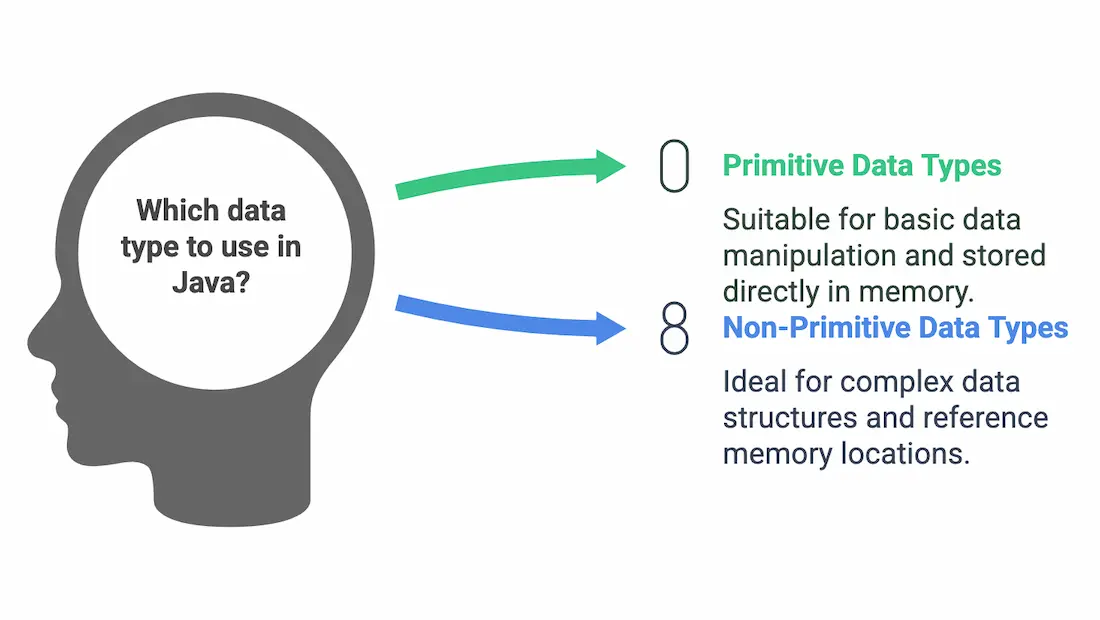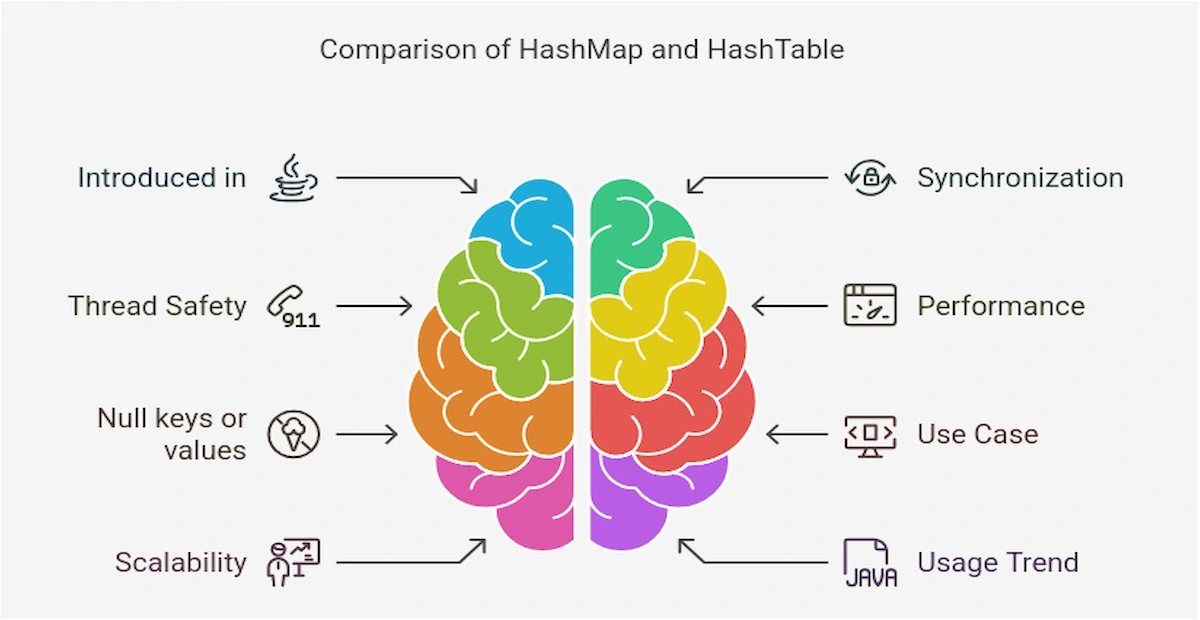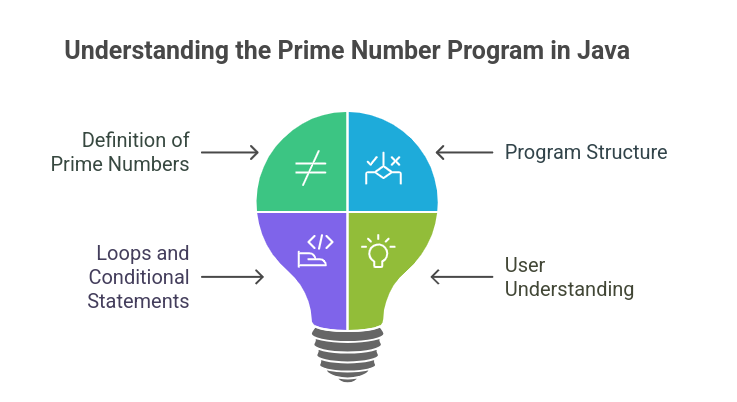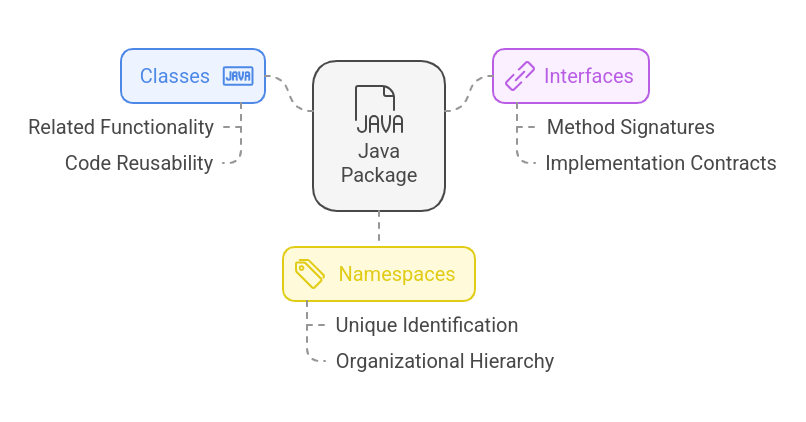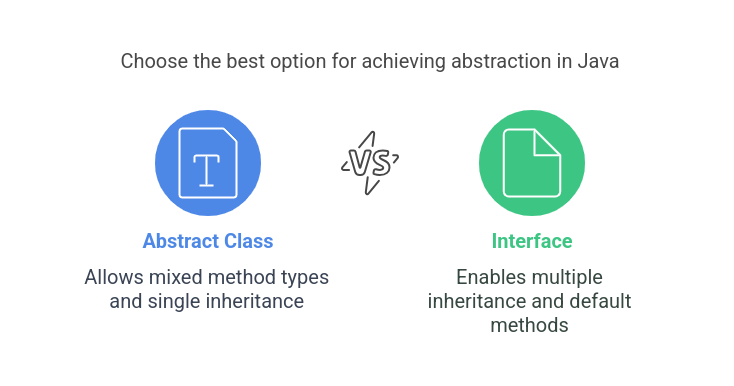- What is Java?
- What are Data Structures?
- What are Data Structures in Java?
- Types of Data Structures in Java
- Advantages of Data Structures in java
- Classification of Data Structures
- Array
- Java Program using Array
- Linked List
- Java Program on Linked List
- Stack
- Java Program using Stack
- Java Data structure program of Stack - using LinkedList
- Queue
- Java program of Queue- using Array
- Demonstration of Queue- using LinkedList
- Binary Tree
- Demonstration of Binary Tree
- Binary Search Tree
- Demonstration of Binary Search Tree
- Heap
- Program of Max Heap
- Hashing
- Demonstration of HashSet - to find string has unique characters
- Demonstration of HashMap - count the characters in a string
- Demonstration of HashTable - to find strings has unique characters
- Graph
- Demonstration of Graph
- Data Structures in Java FAQs
Data structures are fundamental to any programming language. The choice of a particular data structure has a significant impact on the functionality and performance of Java applications, thus it is worthwhile to master data structures in Java.
This guide will help beginners to understand what is data structures, what is data structures in Java, the types of data structures in Java and many more.
What is Java?
Java Programming is a high-level programming language created by sun microsystems. This programming language is reliable, object-oriented and secure. Java follows the WORA principle, which stands for "Write Once Run Anywhere". You can run a java program as many times as you want on a java supported platform after it is compiled.
Learn Java the right way! Our course teaches you essential programming skills, from coding basics to complex projects, setting you up for success in the tech industry.
What are Data Structures?
A data structure is defined as a format for arranging, processing, accessing, and storing data. Data structures are the combination of both simple and complex forms, all of which are made to organise data for a certain use. Users find it simple to access the data they need and use it appropriately thanks to data structures.
To make you understand in simpler terms, look at the below example
If you want to store data in
One on the other - Stacks
Linear fashion - Array/ Linked List
Hierarchical Fashion - Trees
Connect Nodes - Graph
What are Data Structures in Java?
Data Structure in java is defined as the collection of data pieces that offers an effective means of storing and organising data in a computer. Linked List, Stack, Queue, and arrays are a few examples of java data structures.
Types of Data Structures in Java
Here is the list of some of the common types of data structures in Java:
- Array
- Linked List
- Stack
- Queue
- Binary Tree
- Binary Search Tree
- Heap
- Hashing
- Graph
Here is the pictorial representation of types of java data structures

To learn more about Java Programming, you can take up a free online course offered by Great Learning Academy and upskill today. If you are already well-versed with the basics, go ahead and enrol yourself in the Data Structure & Algorithms in Java for Intermediate Level.
Further classification of types of Data Structures
There are two types of Data Structures:-
- Primitive Data Structures
- Non-primitive Data Structures
Primitive data Structures are also called Primitive Data Types. byte, short, int, float, char, boolean, long, and double are primitive Data types.
Non-primitive data Structures - Non-primitive Data Structures are of two types:-
- Linear Data Structures
- Non-linear Data Structures

Linear Data Structures - The elements arranged in a linear fashion are called Linear Data Structures. Here, each element is connected to one other element only. Linear Data Structures are as follows:
- Arrays
- Single dimensional Array
- Multidimensional Array
- Stack
- Queue
- Linked List
- Singly-linked list
- Doubly Linked list
- Circular Linked List
Non-Linear Data Structures - The elements arranged in a non-linear fashion are called Non-Linear Data Structures. Here, each element is connected to n-other elements. Non-Linear Data Structures are as follows:
- Trees
- Binary Tree
- Binary Search Tree
- AVL Tree
- Red-Black Tree
- Heap
- MaxHeap
- MinHeap
Advantages of Data Structures in java
- Efficiency
- Reusability
- Processing Speed
- Abstraction
- Data Searching
Classification of Data Structures
Data Structures can be classified as:-
- Static Data Structures are the Data structures whose size is declared and fixed at Compile Time and cannot be changed later are called Static Data structures.
- Example - Arrays
- Dynamic Data Structures are the Data Structures whose size is not fixed at compile time and can be decided at runtime depending upon requirements are called Dynamic Data structures.
- Example - Binary search tree using Java
- Syntax:
Array declaration
datatype varname []=new datatype[size];
datatype[] varname=new datatype[size];
Array
What is an Array?
An array is the simplest data structure where a collection of similar data elements takes place and each data element can be accessed directly by only using its index number.
Array Advantages
- Random access
- Easy sorting and iteration
- Replacement of multiple variables
Array Disadvantages
- Size is fixed
- Difficult to insert and delete
- If capacity is more and occupancy less, most of the array gets wasted
- Needs contiguous memory to get allocated
Array Applications
- For storing information in a linear fashion
- Suitable for applications that require frequent searching
Java Program using Array
import java.util.*;
class JavaDemo {
public static void main (String[] args) {
int[] priceOfPen= new int[5];
Scanner in=new Scanner(System.in);
for(int i=0;i<priceOfPen.length;i++)
priceOfPen[i]=in.nextInt();
for(int i=0;i<priceOfPen.length;i++)
System.out.print(priceOfPen[i]+" ");
}
}
Input:
23 13 56 78 10
Output:
23 13 56 78 10
Linked List
What is Linked List?
Linked list data structure helps the required objects to be arranged in a linear order.
Linked List Advantages
- Dynamic in size
- No wastage as capacity and size is always equal
- Easy insertion and deletion as 1 link manipulation is required
- Efficient memory allocation
Linked List Disadvantages
- If head Node is lost, the linked list is lost
- No random access is possible
Linked List Applications
- Suitable where memory is limited
- Suitable for applications that require frequent insertion and deletion
Java Program on Linked List
import java.util.*;
class LLNode{
int data;
LLNode next;
LLNode(int data)
{
this.data=data;
this.next=null;
}
}
class Demo{
LLNode head;
LLNode insertInBeg(int key,LLNode head)
{
LLNode ttmp=new LLNode(key);
if(head==null)
head=ttmp;
else
{
ttmp.next=head;
head=ttmp;
}
return head;
}
LLNode insertInEnd(int key,LLNode head)
{
LLNode ttmp=new LLNode(key);
LLNode ttmp1=head;
if(ttmp1==null)
head=ttmp;
else
{
while(ttmp1.next!=null)
ttmp1=ttmp1.next;
ttmp1.next=ttmp;
}
return head;
}
LLNode insertAtPos(int key,int pos,LLNode head)
{
LLNode ttmp=new LLNode(key);
if(pos==1)
{
ttmp.next=head;
head=ttmp;
}
else
{
LLNode ttmp1=head;
for(int i=1;ttmp1!=null && i<pos;i++)
ttmp1=ttmp1.next;
ttmp.next=ttmp1.next;
ttmp1.next=ttmp;
}
return head;
}
LLNode delete(int pos,LLNode head)
{
LLNode ttmp=head;
if(pos==1)
head=ttmp.next;
else
{
for(int i=1;ttmp!=null && i<pos-1;i++)
ttmp=ttmp.next;
ttmp.next=ttmp.next.next;
}
return head;
}
int length(LLNode head)
{
LLNode ttmp=head;
int c=0;
if(ttmp==null)
return 0;
else
{
while(ttmp!=null)
{ ttmp=ttmp.next;
c++;
}
}
return c;
}
LLNode reverse(LLNode head)
{
LLNode prevLNode=null,curLNode=head,nextLNode=null;
while(curLNode!=null)
{
nextLNode=curLNode.next;
curLNode.next=prevLNode;
prevLNode=curLNode;
curLNode=nextLNode;
}
head=prevLNode;
return head;
}
void display(LLNode head)
{
LLNode ttmp=head;
while(ttmp!=null)
{System.out.print(ttmp.data+" ");
ttmp=ttmp.next;
}
}
public static void main(String[] args)
{
LinkedListDemo l=new LinkedListDemo();
l.head=null;
Scanner in=new Scanner(System.in);
do
{
System.out.println("n********* MENU *********");
System.out.println("n1.Insert In End");
System.out.println("n2.Insert In Beg");
System.out.println("n3.Insert At A Particular Pos");
System.out.println("n4.Delete At a Pos");
System.out.println("n5.Length");
System.out.println("n6.Reverse");
System.out.println("n7.Display");
System.out.println("n8.EXIT");
System.out.println("nenter ur choice : ");
int n=in.nextInt();
switch(n)
{case 1: System.out.println("nenter the value ");
l.head=l.insertInEnd(in.nextInt(),l.head);
break;
case 2: System.out.println("nenter the value");
l.head=l.insertInBeg(in.nextInt(),l.head);
break;
case 3: System.out.println("nenter the value");
l.head=l.insertAtPos(in.nextInt(),in.nextInt(),l.head);
break;
case 4:
l.head=l.delete(in.nextInt(),l.head);
break;
case 5:
System.out.println(l.length(l.head));
break;
case 6:
l.head=l.reverse(l.head);
break;
case 7:
l.display(l.head);
break;
case 8: System.exit(0);
break;
default: System.out.println("n Wrong Choice!");
break;
}
System.out.println("n do u want to cont... ");
}while(in.nextInt()==1);
}
}
Output:
********* MENU *********
1.Insert In End
2.Insert In Beg
3.Insert At A Particular Pos
4.Delete At a Pos
5.Length
6.Reverse
7.Display
8.EXIT
enter ur choice :
1
enter the value
23
do u want to cont...
1
********* MENU *********
1.Insert In End
2.Insert In Beg
3.Insert At A Particular Pos
4.Delete At a Pos
5.Length
6.Reverse
7.Display
8.EXIT
enter ur choice :
1
enter the value
56
do u want to cont...
1
********* MENU *********
1.Insert In End
2.Insert In Beg
3.Insert At A Particular Pos
4.Delete At a Pos
5.Length
6.Reverse
7.Display
8.EXIT
enter ur choice :
2
enter the value
10
do u want to cont...
1
********* MENU *********
1.Insert In End
2.Insert In Beg
3.Insert At A Particular Pos
4.Delete At a Pos
5.Length
6.Reverse
7.Display
8.EXIT
enter ur choice :
7
10 23 56
do u want to cont...
1
********* MENU *********
1.Insert In End
2.Insert In Beg
3.Insert At A Particular Pos
4.Delete At a Pos
5.Length
6.Reverse
7.Display
8.EXIT
enter ur choice :
3
enter the value
67
2
do u want to cont...
1
********* MENU *********
1.Insert In End
2.Insert In Beg
3.Insert At A Particular Pos
4.Delete At a Pos
5.Length
6.Reverse
7.Display
8.EXIT
enter ur choice :
7
10 23 67 56
do u want to cont...
1
********* MENU *********
1.Insert In End
2.Insert In Beg
3.Insert At A Particular Pos
4.Delete At a Pos
5.Length
6.Reverse
7.Display
8.EXIT
enter ur choice :
4
2
do u want to cont...
1
********* MENU *********
1.Insert In End
2.Insert In Beg
3.Insert At A Particular Pos
4.Delete At a Pos
5.Length
6.Reverse
7.Display
8.EXIT
enter ur choice :
7
10 67 56
do u want to cont...
1
********* MENU *********
1.Insert In End
2.Insert In Beg
3.Insert At A Particular Pos
4.Delete At a Pos
5.Length
6.Reverse
7.Display
8.EXIT
enter ur choice :
6
do u want to cont...
1
********* MENU *********
1.Insert In End
2.Insert In Beg
3.Insert At A Particular Pos
4.Delete At a Pos
5.Length
6.Reverse
7.Display
8.EXIT
enter ur choice :
7
56 67 10
do u want to cont...
Stack
What is a stack?
A stack is a representation of nodes. There are two components to each node: data and next (storing address of next node). Each node's data portion contains the assigned value, and its next pointer directs the user to the node that has the stack's subsequent item. The highest node in the stack is referred to as the top.
Features of Stack
- Linear Data Structures using Java
- Follows LIFO: Last In First Out
- Only the top elements are available to be accessed
- Insertion and deletion takes place from the top
- Eg: a stack of plates, chairs, etc
- 4 major operations:
- push(ele) - used to insert element at top
- pop() - removes the top element from stack
- isEmpty() - returns true is stack is empty
- peek() - to get the top element of the stack
- All operation works in constant time i.e, O(1)
Stack Advantages
- Maintains data in a LIFO manner
- The last element is readily available for use
- All operations are of O(1) complexity
Stack Disadvantages
- Manipulation is restricted to the top of the stack
- Not much flexible
Stack Applications
- Recursion
- Parsing
- Browser
- Editors
Java Program using Stack
import java.util.*;
class Stack
{
int[] a;
int top;
Stack()
{
a=new int[100];
top=-1;
}
void push(int x)
{
if(top==a.length-1)
System.out.println("overflow");
else
a[++top]=x;
}
int pop()
{
if(top==-1)
{System.out.println("underflow");
return -1;
}
else
return(a[top--]);
}
void display()
{
for(int i=0;i<=top;i++)
System.out.print(a[i]+" ");
System.out.println();
}
boolean isEmpty()
{
if(top==-1)
return true;
else
return false;
}
int peek()
{
if(top==-1)
return -1;
return (a[top]);
}
}
public class Demo
{
public static void main(String args[])
{
Stack s=new Stack();
Scanner in= new Scanner(System.in);
do
{System.out.println("n******** MENU *******");
System.out.println("n1.PUSH");
System.out.println("n2.POP");
System.out.println("n3.PEEK");
System.out.println("n4 IS EMPTY");
System.out.println("n5.EXIT");
System.out.println("n enter ur choice : ");
switch(in.nextInt())
{
case 1:
System.out.println("nenter the value ");
s.push(in.nextInt());
break;
case 2:
System.out.println("n popped element : "+ s.pop());
break;
case 3:
System.out.println("n top element : "+ s.peek());
break;
case 4: System.out.println("n is empty : "+ s.isEmpty());
break;
case 5: System.exit(0);
break;
default: System.out.println("n Wrong Choice!");
break;
}
System.out.println("n do u want to cont... ");
}while(in.nextInt()==1);
}
}
Output:
******** MENU *******
1.PUSH
2.POP
3.PEEK
4 IS EMPTY
5.EXIT
enter ur choice :
1
enter the value
12
do u want to cont...
1
******** MENU *******
1.PUSH
2.POP
3.PEEK
4 IS EMPTY
5.EXIT
enter ur choice :
1
enter the value
56
do u want to cont...
1
******** MENU *******
1.PUSH
2.POP
3.PEEK
4 IS EMPTY
5.EXIT
enter ur choice :
2
popped element : 56
do u want to cont...
1
******** MENU *******
1.PUSH
2.POP
3.PEEK
4 IS EMPTY
5.EXIT
enter ur choice :
4
is empty : false
do u want to cont...
1
******** MENU *******
1.PUSH
2.POP
3.PEEK
4 IS EMPTY
5.EXIT
enter ur choice :
2
popped element : 12
do u want to cont...
Java Data structure program of Stack - using LinkedList
import java.util.*;
class LNode
{
int data;
LNode next;
LNode(int d)
{
data=d;
}
}
class Stack
{
LNode push(int d,LNode head){
LNode tmp1 = new LNode(d);
if(head==null)
head=tmp1;
else
{
tmp1.next=head;
head=tmp1;
}
return head;
}
LNode pop(LNode head){
if(head==null)
System.out.println("underflow");
else
head=head.next;
return head;
}
void display(LNode head){
System.out.println("n list is : ");
if(head==null){
System.out.println("no LNodes");
return;
}
LNode tmp=head;
while(tmp!=null){
System.out.print(tmp.data+" ");
tmp=tmp.next;
}
}
boolean isEmpty(LNode head)
{
if(head==null)
return true;
else
return false;
}
int peek(LNode head)
{
if(head==null)
return -1;
return head.data;
}
}
public class Demo{
public static void main(String[] args)
{
Stack s=new Stack();
LNode head=null;
Scanner in=new Scanner(System.in);
do
{System.out.println("n******** MENU *******");
System.out.println("n1.PUSH");
System.out.println("n2.POP");
System.out.println("n3.PEEK");
System.out.println("n4 IS EMPTY");
System.out.println("n5 DISPLAY");
System.out.println("n6.EXIT");
System.out.println("n enter ur choice : ");
switch(in.nextInt())
{
case 1:
System.out.println("nenter the value ");
head=s.push(in.nextInt(),head);
break;
case 2:
head=s.pop(head);
break;
case 3:
System.out.println("n top element : "+ s.peek(head));
break;
case 4:
System.out.println("n is empty : "+ s.isEmpty(head));
break;
case 5: s.display(head);
break;
case 6: System.exit(0);
break;
default: System.out.println("n Wrong Choice!");
break;
}
System.out.println("n do u want to cont... ");
}while(in.nextInt()==1);
}
}
Output
******** MENU *******
1.PUSH
2.POP
3.PEEK
4 IS EMPTY
5 DISPLAY
6.EXIT
enter ur choice :
1
enter the value
12
do u want to cont...
1
******** MENU *******
1.PUSH
2.POP
3.PEEK
4 IS EMPTY
5 DISPLAY
6.EXIT
enter ur choice :
1
enter the value
56
do u want to cont...
1
******** MENU *******
1.PUSH
2.POP
3.PEEK
4 IS EMPTY
5 DISPLAY
6.EXIT
enter ur choice :
5
list is :
56 12
do u want to cont...
1
******** MENU *******
1.PUSH
2.POP
3.PEEK
4 IS EMPTY
5 DISPLAY
6.EXIT
enter ur choice :
3
top element : 56
do u want to cont...
1
******** MENU *******
1.PUSH
2.POP
3.PEEK
4 IS EMPTY
5 DISPLAY
6.EXIT
enter ur choice :
4
is empty : false
do u want to cont...
1
Queue
What is Queue?
The queue is called an abstract data structure. Data is always added to one end (enqueued), and removed from the other (dequeue). Queue uses the First-In-First-Out approach and data item that was stored initially will be accessed first in a queue.
Features of Queue
- Linear Data Structure
- Follows FIFO: First In First Out
- Insertion can take place from the rear end.
- Deletion can take place from the front end.
- Eg: queue at ticket counters, bus station
- 4 major operations:
- enqueue(ele) - used to insert element at top
- dequeue() - removes the top element from queue
- peekfirst() - to get the first element of the queue
- peeklast() - to get the last element of the queue
- All operation works in constant time i.e, O(1)
Queue Advantages
- Maintains data in FIFO manner
- Insertion from beginning and deletion from end takes O(1) time
Queue Applications
- Scheduling
- Maintaining playlist
- Interrupt handling
Variations in Queue: Two popular variations of queues are Circular queues and Dequeues.
Java program of Queue- using Array
import java.util.*;
class Queue{
int front;
int rear;
int[] arr;
Queue()
{
front=rear=-1;
arr=new int[10];
}
void enqueue(int a)
{
if(rear==arr.length-1)
System.out.println("overflow");
else
arr[++rear]=a;
if(front==-1)
front++;
}
int dequeue()
{
int x=-1;
if(front==-1)
System.out.println("underflow");
else
x=arr[front++];
if(rear==0)
rear--;
return x;
}
void display()
{
for(int i=front;i<=rear;i++)
System.out.print(arr[i]+" ");
System.out.println();
}
}
public class QueueDemo{
public static void main(String[] args)
{
Queue ob=new Queue();
ob.enqueue(1);
ob.enqueue(2);
ob.enqueue(3);
ob.enqueue(4);
ob.enqueue(5);
ob.display();
ob.dequeue();
ob.display();
}
}
Output:
1 2 3 4 5
2 3 4 5
Demonstration of Queue- using LinkedList
class LNode{
int data;
LNode next;
LNode(int d)
{
data=d;
}
}
class Queue{
LNode enqueue(LNode head,int a)
{
LNode tmp=new LNode(a);
if(head==null)
head=tmp;
else
{
LNode tmp1=head;
while(tmp1.next!=null)
tmp1=tmp1.next;
tmp1.next=tmp;
}
return head;
}
LNode dequeue(LNode head)
{
if(head==null)
System.out.println("underflow");
else
head=head.next;
return head;
}
void display(LNode head)
{
System.out.println("n list is : ");
if(head==null){
System.out.println("no LNodes");
return;
}
LNode tmp=head;
while(tmp!=null){
System.out.print(tmp.data+" ");
tmp=tmp.next;
}
}
}
public class QueueDemoLL{
public static void main(String[] args)
{
Queue ob=new Queue();
LNode head=null;
head=ob.enqueue(head,1);
head=ob.enqueue(head,2);
head=ob.enqueue(head,3);
head=ob.enqueue(head,4);
head=ob.enqueue(head,5);
ob.display(head);
head=ob.dequeue(head);
ob.display(head);
}
}
Output
list is :
1 2 3 4 5
list is :
2 3 4 5
Binary Tree
What is a Binary Tree?
In a binary tree, the branches of the tree are made up of up to two child nodes for each node. The left and right nodes are the common names for the two youngsters. Child nodes make references to their parents, whereas parent nodes are nodes with children.
Features of Binary Tree
- Hierarchical Data Structure
- The topmost element is known as the root of the tree
- Every Node can have at most 2 children in the binary tree
- Can access elements randomly using index
- Eg: File system hierarchy
- Common traversal methods:
- preorder(root) : print-left-right
- postorder(root) : left-right-print
- inorder(root) : left-print-right
Binary Tree Advantages
- Can represent data with some relationship
- Insertion and search are much more efficient
Binary Tree Disadvantages
- Sorting is difficult
- Not much flexible
Binary Tree Applications
- File system hierarchy
- Multiple variations of the binary tree have a wide variety of applications
Demonstration of Binary Tree
class TLNode
{
int data;
TLNode left,right;
TLNode(int d)
{
data=d;
}
}
public class BinaryTree
{
static void preorder(TLNode r)
{
if(r==null)
return;
System.out.print(r.data+" ");
preorder(r.left);
preorder(r.right);
}
static void inorder(TLNode r)
{
if(r==null)
return;
inorder(r.left);
System.out.print(r.data+" ");
inorder(r.right);
}
static void postorder(TLNode r)
{
if(r==null)
return;
postorder(r.left);
postorder(r.right);
System.out.print(r.data+" ");
}
public static void main(String[] args)
{
TLNode root=new TLNode(1);
root.left=new TLNode(2);
root.right=new TLNode(3);
root.left.left=new TLNode(4);
root.left.right=new TLNode(5);
root.right.left=new TLNode(6);
root.right.right=new TLNode(7);
preorder(root);
System.out.println();
inorder(root);
System.out.println();
postorder(root);
System.out.println();
}
}
Output
1 2 4 5 3 6 7
4 2 5 1 6 3 7
4 5 2 6 7 3 1
Binary Search Tree
What is a Binary Search Tree?
The binary search tree is an advanced algorithm which is used to analyse the nodes, branches and many more. The BST was developed using the architecture of a fundamental binary search algorithm, allowing for quicker node lookups, insertions, and removals.
Features of Binary Search Tree
- A binary tree with the additional restriction
- Restriction:
- The left child must always be less than the root node
- The right child must always be greater than the root node
- Insertion, Deletion, Search is much more efficient than a binary tree
Binary Search Tree Advantages
- Maintains order in elements
- Can easily find the min and max Nodes in the tree
- In order, traversal gives sorted elements
Binary Search Tree Disadvantages
- Random access is not possible
- Ordering adds complexity
Binary Search Tree Applications
- Suitable for sorted hierarchical data
Demonstration of Binary Search Tree
class TLNode{
int data;
TLNode left,right;
TLNode(int d)
{
data=d;
}
}
public class BST{
TLNode root;
TLNode insert(int d,TLNode root)
{
if(root==null)
root=new TLNode(d);
else if(d<=root.data)
root.left=insert(d,root.left);
else
root.right=insert(d,root.right);
return root;
}
TLNode search(int d,TLNode root)
{
if(root.data==d)
return root;
else if(d<root.data)
return search(d,root.left);
else
return search(d,root.right);
}
void inorder(TLNode r)
{
if(r==null)
return;
inorder(r.left);
System.out.println(r.data);
inorder(r.right);
}
TLNode delete(TLNode root, int data)
{
if (root == null) return root;
if (data < root.data)
root.left = delete(root.left, data);
else if (data > root.data)
root.right = delete(root.right, data);
else
{
if (root.left == null)
return root.right;
else if (root.right == null)
return root.left;
root.data = minValue(root.right);
root.right = delete(root.right, root.data);
}
return root;
}
int minValue(TLNode root)
{
int minv = root.data;
while (root.left != null)
{
minv = root.left.data;
root = root.left;
}
return minv;
}
public static void main(String[] args)
{
BST ob=new BST();
ob.root=ob.insert(50,ob.root);
ob.root=ob.insert(30,ob.root);
ob.root=ob.insert(20,ob.root);
ob.root=ob.insert(20,ob.root);
ob.root=ob.insert(70,ob.root);
ob.root=ob.insert(60,ob.root);
ob.root=ob.insert(80,ob.root);
ob.root=ob.delete(ob.root,50);
System.out.println("******" +ob.root.data);
ob.inorder(ob.root);
TLNode find=ob.search(30,ob.root);
if(find==null)
System.out.println("not found");
else
System.out.println("found : "+find.data);
}
}
Output:
******60
20
20
30
60
70
80
found : 30
Heap
- Binary Heap can be visualized array as a complete binary tree
- Arr[0] element will be treated as root
- length(A) - size of array
- heapSize(A) - size of heap
- Generally used when we are dealing with minimum and maximum elements
- For ith node
| (i-1)/2 | Parent |
| (2*i)+1 | Left child |
| (2*i)+2 | Right Child |
Heap Advantages
- Can be of 2 types: min heap and max heap
- Min heap keeps the smallest element and top and max keep the largest
- O(1) for dealing with min or max elements
Heap Disadvantages
- Random access is not possible
- Only min or max element is available for accessibility
Heap Applications
- Suitable for applications dealing with priority
- Scheduling algorithm
- caching
Program of Max Heap
import java.util.*;
class Heap{
int heapSize;
void build_max_heap(int[] a)
{
heapSize=a.length;
for(int i=(heapSize/2);i>=0;i--)
max_heapify(a,i);
}
void max_heapify(int[] a,int i)
{
int l=2*i+1;
int r=2*i+2;
int largest=i;
if(l<heapSize &&a[l]>a[largest])
largest=l;
if(r<heapSize &&a[r]>a[largest])
largest=r;
if(largest!=i)
{
int t=a[i];
a[i]=a[largest];
a[largest]=t;
max_heapify(a,largest);
}
}
//to delete the max element
int extract_max(int[] a)
{
if(heapSize<0)
System.out.println("underflow");
int max=a[0];
a[0]=a[heapSize-1];
heapSize--;
max_heapify(a,0);
return max;
}
void increase_key(int[] a,int i,int key)
{
if(key<a[i])
System.out.println("error");
a[i]=key;
while(i>=0 && a[(i-1)/2]<a[i])
{
int t=a[(i-1)/2];
a[(i-1)/2]=a[i];
a[i]=t;
i=(i-1)/2;
}
}
void print_heap(int a[])
{
for(int i=0;i<heapSize;i++)
System.out.println(a[i]+" ");
}
}
public class HeapDemo{
public static void main(String[] args)
{
Scanner in=new Scanner(System.in);
int n=in.nextInt();
int a[]=new int[n];
System.out.println("enter the elements of array");
for(int i=0;i<n;i++)
a[i]=in.nextInt();
Heap ob=new Heap();
ob.build_max_heap(a);
ob.print_heap(a);
System.out.println("maximum element is : "+ob.extract_max(a));
ob.print_heap(a);
System.out.println("maximum element is : "+ob.extract_max(a));
ob.increase_key(a,6,800);
ob.print_heap(a);
}
}
Output
7
enter the elements of array
50 100 10 1 3 20 5
100
50
20
1
3
10
5
maximum element is : 100
50
5
20
1
3
10
maximum element is : 50
800
5
20
1
3
Hashing
- Uses special Hash function
- A hash function maps an element to an address for storage
- This provides constant-time access
- Collision resolution techniques handle collision
- Collision resolution technique
- Chaining
- Open Addressing
Hashing Advantages
- The hash function helps in fetching elements in constant time
- An efficient way to store elements
Hashing Disadvantages
- Collision resolution increases complexity
Hashing Applications
- Suitable for the application needs constant time fetching
Demonstration of HashSet - to find string has unique characters
import java.util.*;
class HashSetDemo1{
static boolean isUnique(String s)
{
HashSet<Character> set =new HashSet<Character>();
for(int i=0;i<s.length();i++)
{
char c=s.charAt(i);
if(c==' ')
continue;
if(set.add(c)==false)
return false;
}
return true;
}
public static void main(String[] args)
{
String s="helo wqty ";
boolean ans=isUnique(s);
if(ans)
System.out.println("string has unique characters");
else
System.out.println("string does not have unique characters");
}
}
Output:
string has unique characters
Demonstration of HashMap - count the characters in a string
import java.util.*;
class HashMapDemo
{
static void check(String s)
{
HashMap<Character,Integer> map=new HashMap<Character,Integer>();
for(int i=0;i<s.length();i++)
{char c=s.charAt(i);
if(!map.containsKey(c))
map.put(c,1);
else
map.put(c,map.get(c)+1);
}
Iterator<Character> itr = map.keySet().iterator();
while (itr.hasNext()) {
Object x=itr.next();
System.out.println("count of "+x+" : "+map.get(x));
}
}
public static void main(String[] args)
{
String s="hello";
check(s);
}
}
Output
count of e : 1
count of h : 1
count of l : 2
count of o : 1
Demonstration of HashTable - to find strings has unique characters
import java.util.*;
class hashTabledemo {
public static void main(String[] arg)
{
// creating a hash table
Hashtable<Integer, String> h =
new Hashtable<Integer, String>();
Hashtable<Integer, String> h1 =
new Hashtable<Integer, String>();
h.put(3, "Geeks");
h.put(2, "forGeeks");
h.put(1, "isBest");
// create a clone or shallow copy of hash table h
h1 = (Hashtable<Integer, String>)h.clone();
// checking clone h1
System.out.println("values in clone: " + h1);
// clear hash table h
h.clear();
// checking hash table h
System.out.println("after clearing: " + h);
System.out.println("values in clone: " + h1);
}
}
Output
values in clone: {3=Geeks, 2=forGeeks, 1=isBest}
after clearing: {}
values in clone: {3=Geeks, 2=forGeeks, 1=isBest}
Graph
- Basically it is a group of edges and vertices
- Graph representation
- G(V, E); where V(G) represents a set of vertices and E(G) represents a set of edges
- The graph can be directed or undirected
- The graph can be connected or disjoint
Graph Advantages
- finding connectivity
- Shortest path
- min cost to reach from 1 pt to other
- Min spanning tree
Graph Disadvantages
- Storing graph(Adjacency list and Adjacency matrix) can lead to complexities
Graph Applications
- Suitable for a circuit network
- Suitable for applications like Facebook, LinkedIn, etc
- Medical science
Demonstration of Graph
import java.util.*;
class Graph
{
int v;
LinkedList<Integer> adj[];
Graph(int v)
{
this.v=v;
adj=new LinkedList[v];
for(int i=0;i<v;i++)
adj[i]=new LinkedList<Integer>();
}
void addEdge(int u,int v)
{
adj[u].add(v);
}
void BFS(int s)
{
boolean[] visited=new boolean[v];
LinkedList<Integer> q=new LinkedList<Integer>();
q.add(s);
visited[s]=true;
while(!q.isEmpty())
{
int x=q.poll();
System.out.print(x+" ");
Iterator<Integer> itr=adj[x].listIterator();
while(itr.hasNext())
{
int p=itr.next();
if(visited[p]==false)
{
visited[p]=true;
q.add(p);
}
}
}
}
void DFSUtil(int s,boolean[] visited)
{
visited[s]=true;
System.out.println(s);
Iterator<Integer> itr=adj[s].listIterator();
while(itr.hasNext())
{
int x=itr.next();
if(visited[x]==false)
{
//visited[x]=true;
DFSUtil(x,visited);
}
}
}
void DFS(int s){
boolean visited[]=new boolean[v];
DFSUtil(s,visited);
}
public static void main(String[] args)
{
Graph g=new Graph(4);
g.addEdge(0,1);
g.addEdge(0,2);
g.addEdge(1,2);
g.addEdge(2,0);
g.addEdge(2,3);
g.addEdge(3,3);
g.BFS(2);
g.DFS(2);
}
}
Output:
2 0 3 1 2
0
1
3
Data Structures in Java FAQs
Yes, you can use Java for data structures. Here, Java is just a programming language, and data structures help in storing and organizing the data in the required format.
Some of the data structures of Java are:Linked Lists
Arrays
Stack
Queue
Graph
Set
There is no such best data structure for Java. But programmers will use arrays as it is one of the simplest and most widely used data structures.
For different problems, different data structures are the fastest. But in general, arrays are the fastest data structures in Java as it is a simple data structure.
Yes, learning data structures in Java helps you in enhancing your programming knowledge. It is said that Data structures + Algorithms = Programs, so learning data structures is important.
Language is just a medium, but in the current trend, Java or Python is the best language for DSA.
There are 2 data structures in Java. They are linear and non-linear (hierarchical) data structures.
Engaging in the study of Java programming suggests a keen interest in the realm of software development. For those embarking upon this journey with aspirations towards a career in this field, it is recommended to explore online courses with certificates in order to acquire a comprehensive understanding of the development career path and gain valuable credentials.


